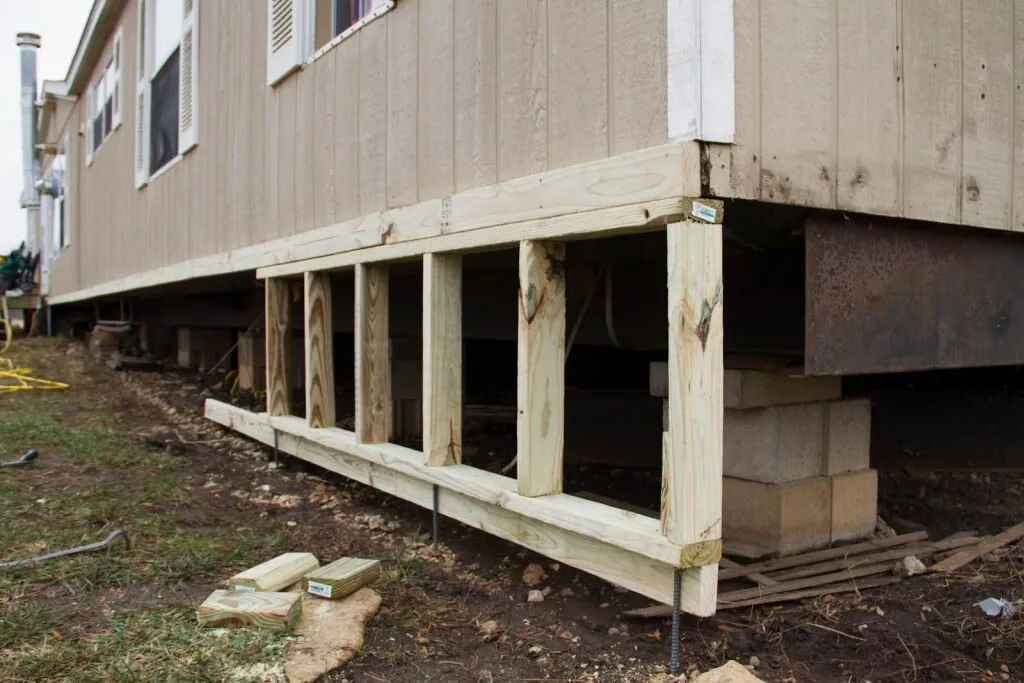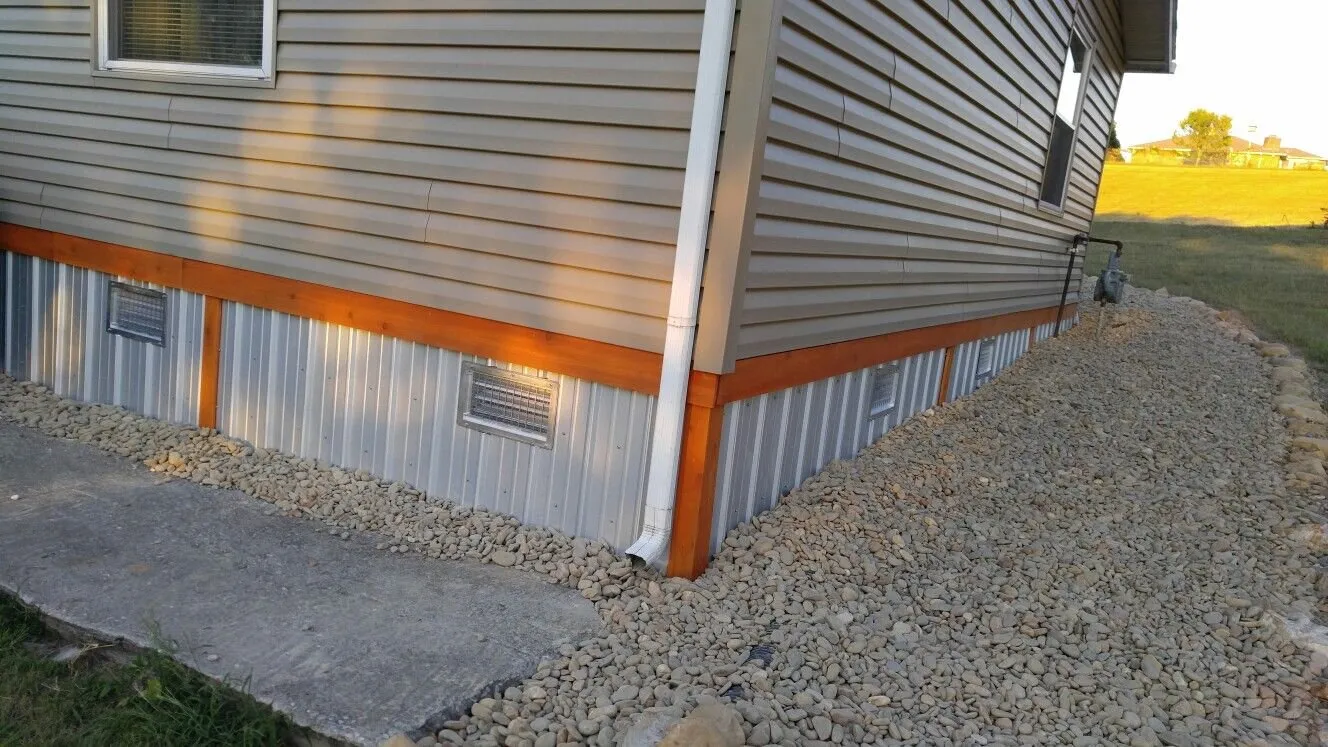Have you noticed cracks, holes, or peeling paint on the skirting of your mobile home? Don’t let these small issues turn into bigger problems. Mobile home skirting not only adds visual appeal to your property but it also protects the foundation and keeps critters out.
In this guide, we’ll take you through the steps to repair or replace your mobile home skirting so you can enjoy a sturdy and attractive exterior once again! So grab your tool kit and let’s get started on bringing back that curb appeal!
What Skirting in Mobile Homes
Skirting is a vital component of mobile homes and serves multiple purposes. It is the material that encloses the space between the ground and your home, creating a barrier that protects against pests, debris, and weather elements. Mobile home skirting also helps to control temperature by insulating your home’s underbelly from extreme temperatures.
There are various types of skirting materials available in the market such as vinyl, wood or metal panels, concrete blocks or piers, and faux brick or rock siding among others. Each material has its own pros and cons when it comes to durability, maintenance requirements, and aesthetic appeal.
Choosing the right type of skirting for your mobile home depends on factors like local climate conditions, budget constraints, and personal preferences. Some homeowners prefer to match their skirting with their property’s exterior decor while others prioritize low-maintenance options that offer long-term value for money.
Regardless of what you choose as your preferred skirting material though – remember that regular inspection and repair will help keep it functioning properly for years to come!

Mobile home skirting-repair
When to Repair or Replace Skirting
Skirting is an essential component of mobile homes that serves several purposes, including insulation and aesthetics. However, over time, skirting may deteriorate due to various reasons such as natural wear and tear or external elements. Therefore, it becomes necessary to check for signs of damage regularly
- Peeling or cracked paint on the skirting panels can be indicative of water damage or moisture retention.
- Visible holes in the skirting allow pests such as rats and insects easy access into your home’s underbelly.
- Dents or scratches on the surface could result from accidental impacts with objects like lawnmowers.
- Warped panels often occur when there are changes in temperature, resulting in the contraction and expansion of materials used to make the skirting.
- Rust occurs when metals used to construct the skirting come into contact with moisture over a prolonged period.
- The erosion of stones used for decorative purposes can also lead to weakening structures around your mobile home.
- A sudden change in your electric bill could point towards insulation issues caused by damaged skirting panels.
If you notice any of these warning signs, consider repairing or replacing your mobile home’s damaged skirt immediately before they worsen
Mobile Home Skirting Repair step-by-step
Mobile home skirting is an essential part of any mobile home. It protects the underside of your home from moisture, pests, and wind damage. Over time, however, skirting may begin to deteriorate or become damaged. This is where repairing or replacing it comes into play.
1. Inspection
Before beginning any mobile home skirting repair project, it’s important to perform a thorough inspection of the skirting. This will help identify any areas that need attention and determine if you need to replace or repair the existing materials.
Start by looking for peeling or cracked paint on the surface of your mobile home skirting. These are signs of wear and tear that can lead to further damage over time. It’s essential to address these issues promptly before they become more severe.
Next, check for visible holes in the panels, dents or scratches on metal components, warped panels caused by exposure to moisture and temperature changes, and rusted metal parts due to water damage or erosion of the stone.
Additionally, keep an eye out for sudden spikes in your electric bill as this could indicate insulation problems behind your mobile home skirting.
Take note of any other potential issues such as mold growth under the skirting or animal infestations that could be causing damage from within.
2. Cleaning
Before moving on with the repair process, it’s imperative to clean the skirting thoroughly. Cleaning not only helps in improving the appearance of your mobile home but also ensures that there are no hidden damages beneath dirt and grime.
Start by removing any debris or loose particles using a broom or a vacuum cleaner. Next, use a pressure washer to remove stubborn stains and dirt build-up from the surface of your skirting panels. Make sure to use an appropriate cleaning solution that won’t damage your skirting material.
If you opt for manual cleaning, then select a mild detergent solution mixed with warm water and scrub gently using a soft-bristled brush. Avoid using abrasive cleaners, steel wool, or sandpaper as they can cause scratches on your panels.
After cleaning is complete, rinse off all soap residues thoroughly with clean water and let dry completely before proceeding with repairs or replacements.
It’s essential to ensure proper sanitation procedures while handling moldy areas present around skirting panels during cleaning processes. Protective gear like gloves and masks should be worn during this process as well to protect yourself from harmful substances.
3. Fill in the Holes
To fill in the holes of your mobile home skirting, first, remove the damaged parts using a saw or cutting tool. You may also need to pry open some panels for easier access. After that, measure the size of the hole and cut a piece of new paneling with the appropriate size.
Fit the new panel into place by securing it with screws or nails around its edges. Fill any gaps between the old and new panels with expanding foam insulation before caulking along their seams for additional waterproofing.
Make sure to paint or coat your newly repaired mobile home skirting with a sealant that is suitable for outdoor use. This will help prevent future damage caused by moisture or insects.
Remember that filling in holes on your mobile home skirting is just one part of proper maintenance practices that will ensure the longevity of this important element protecting your property’s foundation.

New mobile home skirting
4. Replacement
Sometimes replacement is the best option when the edamame is irreparable. This may be necessary if the skirting has significant damage or wear that cannot be repaired.
The first step in the replacement process is to remove the old skirting. This can typically be done by prying off panels with a pry bar and removing any screws holding them in place.
Once all of the old skirtings are removed, you will need to measure your new skirting materials carefully and cut them to size using a saw or other cutting tool.
Next, install your new skirting panels according to manufacturer instructions. It’s important to make sure they are level and secure so that they do not shift or warp over time.
Add any finishing touches such as trim pieces or paint as needed. Your newly replaced mobile home skirting should look fresh and provide adequate protection for years to come.
5. Waterproofing
Waterproofing is a crucial step that should never be overlooked. Without proper waterproofing, your skirting will be vulnerable to water damage and mold growth.
To start the waterproofing process, make sure you clean the area thoroughly and let it dry completely before applying any sealant or coating. Once the area is dry, apply a high-quality sealant designed for use on mobile home skirting.
Be sure to pay special attention to areas where there may be gaps or cracks in your skirting panels. These areas are particularly susceptible to water damage and should receive extra attention during the waterproofing process.
In addition to sealing any gaps or cracks in your skirting panels, consider adding an additional layer of protection by installing a vapor barrier underneath your mobile home. This will help prevent moisture from seeping up through the ground and causing damage from below.
Proper waterproofing is essential for protecting your mobile home’s foundation and ensuring its longevity. By taking the time to properly seal and protect your skirting against moisture damage, you can help keep it looking great for years to come without having to worry about costly repairs down the line.
Final Thoughts
Mobile home skirting repair may seem like a daunting task, but with the right steps and preparation, it can be a DIY project that saves you money while also improving your home’s appearance and functionality. Remember to inspect your skirting regularly and address any issues promptly to prevent further damage. By following this mobile home skirting repair guide, you’ll have all the necessary knowledge to make repairs or replacements as needed.
Whether you’re looking for ways to improve energy efficiency or simply want to update your mobile home’s exterior, proper maintenance of your skirting is essential. With these tips in mind, you can ensure that your mobile home remains comfortable and secure for years to come. So go ahead – tackle those repairs head-on and enjoy the benefits of a well-maintained mobile home!
See Also:
- Mobile Home Carport Buying Guide for Beginners
- How to Flip Mobile Homes for Profit
- Do Manufactured Homes’ Value in Florida Depreciate?
- Mobile Home For Sale by Owner (FSBO) Pros and Cons
- Mobile Home Roof Repair Guide


For the most part, my mother bil has a lot of holes in the skirting. Many holes were made from the lawnmower. What can I cover the holes with that will match the size ding? I’m not replacing it with new, that is not an option.
Hi Sally!
Thanks for the comment. Most mobile home parts stores offer replacement parts for yoru skirting that will meet your needs.
Good Luck!